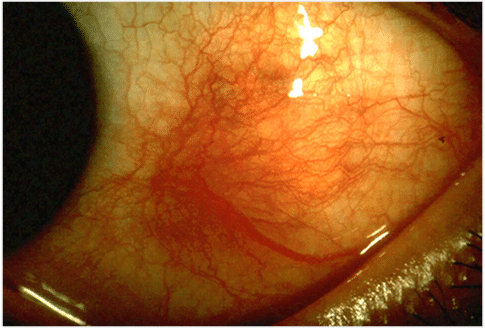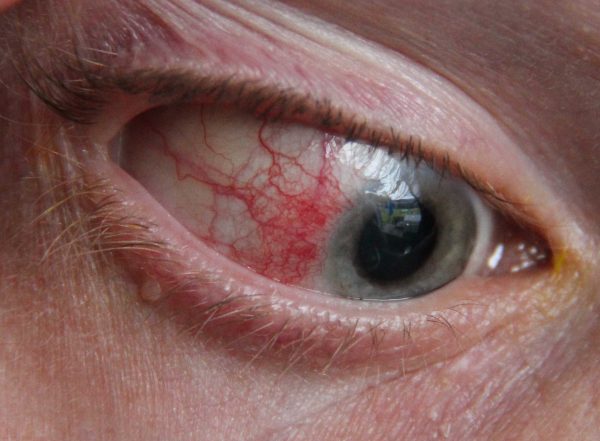Scleritis refers to the inflammation of the sclera in your eye. It can result in pain, swelling, and redness of your eyes. The condition may suggest you have some autoimmune disorder. It does mean that when you suffer from inflammation of your sclera it means you have underlying health issues. Simple causes can also result in the condition. So, it is important to get to the bottom of the uncommon issue affected your eyes. Without proper diagnosis and management, the problem aggravates and results in vision loss. It is a serious condition. Therefore, never ignore it and see an ophthalmologist as early as possible.
The sclera is the white portion of your eye. The white tissue is tough and gives shape to the eye. It also offers protection. Your eye is a delicate organ. So, injuries or trauma can lead to the inflammation of the sclera. In other cases, the inflammation occurs when another disease affecting the whole body attacks the eyes. So, when you suffer from autoimmune diseases like rheumatoid arthritis, you can experience red-eye. You need more information about the topic to understand its seriousness. So, it will help you take the necessary action without any delay. Read ahead to know more about it.
Learn More About Scleritis
The sclera is the outer layer of your eye. It offers protection to your eye and keeps the delicate structure safe. In simple terms, it is the white part of your eye. The layer surrounds your cornea and forms more than 80 percent of the eyeball surface area. It extends from your cornea to the optic nerve. Your optic nerve exits at the back of the eye. But, only a small portion of the sclera is visible. The sclera is connected to the muscles, which helps with eye movement. The sclera is composed of small fibers of collagen that are arranged randomly, interweaving the connective fiber tissue. So, it offers great flexibility and strength to the eyeball.

When your sclera becomes inflamed, it can result in severe redness. So, your eye appears red and swollen. It is a serious disorder occurring due to the overreaction of your body’s immune system. But, the condition can also occur due to trauma or other reasons. The type of eye disorder depends on the location of the inflammation. The condition mostly occurs in people between the ages of 30 and 60. So, it normally does not affect children. Without proper treatment, the condition spreads to other parts of the eye. It results in partial or complete vision loss. To prevent the progression of the condition, you need medical attention. Early treatment can prevent worsening of the condition and the severity of the symptoms.
Types Of Scleritis

Anterior Scleritis
It is a commonly occurring problem. The condition affects the front part of the sclera. In the majority of cases, the anterior forms occur due to some illness.
Necrotizing Anterior Scleritis
It is the most serious form of inflammation of sclera. You can experience severe pain as a result of the condition. It also causes tenderness of the sclera.
Posterior Scleritis
The condition affects the back part of the sclera. So, it is difficult to diagnose as you cannot any visible signs. It also has variable symptoms. As it mimics several other disorders, your doctor needs to perform a thorough, evaluation to detect the issue.
Symptoms Of Scleritis

In most of the cases, the condition occurs gradually. You develop severe pain and inflammation over several days. You can feel piercing pain when you move your eye. Usually, the inflammation begins in one area and it spreads to the entire white region of your eye. Although you have different types of scleritis, the symptoms are similar to each other. All conditions can worsen without any medical treatment. Without treatment, the pain can spread to your face. It mainly affects the side of the eye affected by the inflammation. So, it prevents you from functioning properly. When the pain fails to respond to the normal pain killer, you need to monitor for other signs. The signs indicating the inflammation of sclera are:
- Decreased vision
- Excessive lacrimation or tearing
- Blurry vision
- Photophobia (sensitivity to light)
- Red-eye (redness in the white portion of your eye)
Posterior scleritis symptoms are not visible to you. It is because the problem does not trigger pain like the other types. So, you need to look out for the other signs like:
- Deep-rooted headaches
- Eye irritation
- Pain while moving the eye
- Double vision
In some cases, people may not experience symptoms when they suffer from inflammation of sclera. It is possible due to the following factors:
- You suffer from a milder case of inflammation
- The presence of scleromalacia perforans (it is the rare complication associated with advanced rheumatoid arthritis)
- Your use of immunosuppressive medications (the medication prevents the immune system from reacting to the inflammation) before you see symptoms
So, you need to see an ophthalmologist get a proper diagnosis and ideal treatment. With medical management, you can prevent any complications.
Causes Of Scleritis
The exact cause of the inflammation of sclera remains unclear. Several theories exist to explain the condition. Many doctors believe the problem with your immune system’s T cells results in the inflammation. The human immune system is a network, which consists of tissues, organs, and circulating cells. The network works together to prevent bacteria and viruses from attacking your body and trigger illness. The T cells in your immune system work to kill any harmful organisms (pathogen) that can cause illness. Due to the problems with your T cells, they begin attacking the scleral cells. Why they begin attacking the eye’s scleral cells remains unknown.
Risk Factors Associated With Scleritis
Inflammation to sclera can affect anyone at any age. In the majority of cases, women are more at risk of the problem compared to men. It affects people from all races or any area of the world. But, certain health factors make you more vulnerable to the problem compared to others. You have increased chances of developing the problem when you have:
Wegener’s disease
If you suffer from Wegener’s granulomatosis, the rare condition triggering inflammation of the blood vessels, then you are more prone to inflammation of sclera.
Rheumatoid Arthritis (RA)
People suffering from autoimmune disorder have more chances of suffering from the red-eye. The disorder causing inflammation of your joints can also cause problems to the sclera.
Inflammatory Bowel Disease (IBD)
It is the problem, which causes problems for your digestive organs. In most of the cases, the inflammation affects the bowel region. So, you can experience several digestive symptoms associated with it. People suffering from IBD can suffer from inflammation of sclera. It is because the tissues that form the eye are similar to the tissues in your digestive tract. Therefore, the inflammation can affect other organs like the white part of the eyes.
Sjogren’s syndrome
It is another autoimmune disorder triggering several problems in your body. When you suffer from the problem your immune system attacks your own body by mistake. Sjogren’s syndrome causes the immune system to attack salivary and tear glands. So, it causes dry eye and inflammation of the white part of the eye.
Lupus
People suffering from autoimmune diseases like lupus can become more vulnerable to inflammation. When you suffer from the condition, your body’s immune system attacks organs and tissues. So, the inflammation triggered by lupus affects many-body systems. It affects the lungs, heart, brain, kidneys, skin, joints, and blood cells. The condition also changes skin around the eyelids. You can suffer from different ocular issues like dry eyes, blood vessel changes in the retina, nerve damage causing problems with eye movement, and inflammation of the white layer of your eyeball. The condition worsens and leads to vision loss.
Eye Infections
You are more at risk of developing inflammation of sclera when you suffer from eye infections. The infection may or may not related to autoimmune disease can make you vulnerable to the red-eye.
Trauma
Any trauma or accident can cause damage to your tissues in the eye. It can make you susceptible to inflammation of sclera.
Complications Due To Scleritis
The inflammation of sclera needs prompt medical attention. Without proper treatment, the condition spreads to other parts of the eye. So, you become more vulnerable to the following complications:
Keratitis
The inflammation can spread to the cornea. The cornea is the clear dome present on the front surface of your eye. The inflammation can trigger moderate to severe pain.
Uveitis
The condition affects your uvea (the middle layer of tissue existing in the eyewall). The inflammation often comes suddenly and worsens quickly.
Cataract
It is the problem that causes a problem to your vision. Cataracts can cloud your lens and make it difficult for you to see things.
Glaucoma
When you fail to receive treatment for inflammation of the sclera, it can lead to complications like glaucoma. Though it is rare, inflammation of sclera can cause permanent damage to the trabecular meshwork present at the base of cornea. It is a risk factor in people suffering from posterior scleritis.
So, never ignore the problem. Get prompt medical attention to prevent the worsening of the symptoms. You can avoid permanent damage to your eye with immediate medical attention.
Diagnosing Scleritis
When you observe the symptoms like red-eye, you need to see an ophthalmologist. The specialist doctor assesses the problem in detail to determine the underlying cause. Inflammation to sclera has symptoms similar to several other ocular problems. So, your eye doctor needs to rule out the following:
Blepharitis
It is inflammation affecting the outer eyelid. The condition can trigger several symptoms, including the red-eye.
Episcleritis

It is a medical term used to refer to the inflammation affecting the episclera (the outermost layer of your eye). The inflammation affects the superficial vessels in the episclera.
Conjunctivitis
Conjunctivitis is another common problem causing red-eye. It can occur due to inflammation triggered by a virus or bacteria.
Diagnostic Tests
So, to rule out the possibility of other conditions and confirm the presence of scleritis, your eye doctor has to perform diagnostic tests. The following tests can help detect the problem.
Eye Examination
The red-eye can occur due to several different conditions. So, your eye doctor performs an examination and reviews your medical history. You need to convey about your prior medical condition. You need to tell the doctor about prior eye surgery or trauma to the eye. Answer questions about the systemic conditions of history truthfully. Certain health conditions can trigger eye problem like:
- Eye problems due to IBD (inflammatory bowel disease)
- Wegner’s granulomatosis (rare disease-causing inflammation of the blood vessels in various tissues)
- Inflammation of sclera due to RA (Rheumatoid arthritis)
You need to provide all the necessary information to your doctor. Based on the information collected, your eye doctor can suggest other tests to make a conclusive diagnosis.
Ultrasonography
Ultrasonography uses sound waves to get images of your eyes. The images can help the ophthalmologist to look for changes in your eyes. It specifically focusses on the area in and around sclera.
Blood Tests
The doctor can order a complete blood count test. The blood test can check for immune system activity and any signs of infection.
Biopsy
A sample of your sclera is removed by the doctor and sent to the lab for testing. The tissue sample is examined under the microscope to detect the problem conclusively.
Treatment For Scleritis
The treatment for inflammation sclera mainly focuses on fighting off the infection. It is important to get medical assistance as early as possible. Without medical management, the inflammation can escalate and cause permanent damage to your eyes. The treatment eases the symptoms like pain and swelling associated with the condition. So, you need to follow the treatment suggested by the doctor to reduce the signs and symptoms. The treatment for scleritis has a stepladder approach. The first medication is tried to see results. If you fail to see improvement, then the next method is selected. It is continued to find the best solution for your condition. Therefore, the medications used to treat the red eye are:
Nonsteroidal Anti-Inflammatory Drugs (NSAIDs)
Your eye doctor prescribes nonsteroidal anti-inflammatory drugs to treat the inflammation. It is usually prescribed for nodular anterior type. The medication helps reduce the inflammation and pain associated with the condition. So, you can get relief after taking the medications.
Corticosteroids
Oral corticosteroid is prescribed when the NSAIDs fail to offer results. So, it is the second step of the treatment. You can take corticosteroid pills like prednisone to get relief.
Oral Glucocorticoids
Glucocorticoids are the steroids naturally produced in your body. the glucocorticoid drugs are the man-made version of the naturally occurring steroids. It is ideal for interrupting inflammation moving into your cells. It also suppresses the protein that promotes inflammation. The medication is usually suggested for posterior scleritis.
Immunosuppressive Drugs
The doctor prescribes immunosuppressive drugs for severe cases of inflammation. So, it is an ideal treatment option for cases that shows no visible improvement to high dose corticosteroids. It is also suggested for patients who cannot take high doses of corticosteroids. Therefore, your doctor can prescribe it with oral glucocorticoids to get positive results. The medication is usually suggested for necrotizing scleritis.
Antibiotics
Antibiotics are suggested for inflammation of sclera due to viral or bacterial infection. The medication can also prevent the infection. It is used in combination with corticosteroids to get the best results. But, it is not ideal for fungal infection.
Antifungal Medications
Fungus triggering the infections need antifungal medications. People suffering from Sjogren’s syndrome must also take antifungal medications to get relief from the symptoms.
Surgery
An invasive procedure is the last option to treat severe cases of inflammation, which does not respond to other medications. Surgery is performed by the ophthalmologist to repair tissues present in the sclera. The invasive procedure improves the muscle function in your eyes. It also prevents further complications, including vision loss.
In most of the cases, sclera treatment depends on treating the underlying cause. So, treating the autoimmune disorder, injury or infection can effectively treat the condition. With proper management and care, you can prevent the recurrence of the condition.
Preventing Scleritis
Can you take steps to prevent inflammation of sclera? Yes, it is possible to prevent the inflammation and subsequent problems associated with it. You have to follow the steps suggested below to ensure eye safety and prevent any complications:
Avoid Eye Injury
Eye injury is one of the main cause of scleritis. Therefore, you need to take steps to keep your eye safe from injuries and trauma. Follow the safety guidelines while working in condition increases your risk of eye injuries. So, wear protective eyewear without fail to prevent any trauma to your eyes.
Manage Rheumatoid Arthritis
You have no permanent cure available for rheumatoid arthritis. But, you can manage the symptoms associated with the problem. Get medical assistance and take medications as prescribed by the doctor to prevent any complications arising due to the inflammation of joints.
Conclusion
Scleritis is a serious condition requiring immediate medical assistance. If you ignore the problem, it can cause significant damage to your eye. With treatment, you can suffer from partial or complete vision loss. So, you need to seek treatment from an ophthalmologist to prevent necrotizing scleritis, which causes loss of vision. Even with medical care, the condition can recur. It is essential to make an appointment for follow-up care with the eye doctor regularly to ensure the condition does not return. It will also help catch the early signs of the problem and get proper treatment as early as possible. Treatment based on the underlying cause can prevent future issues associated with inflammation of sclera.
View Article Sources
